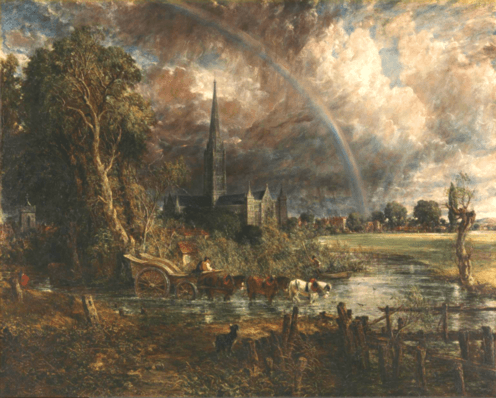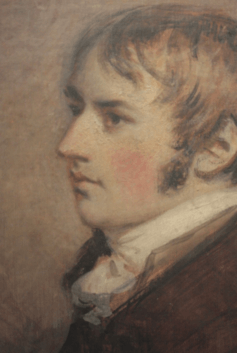Chasing the rainbow: how John Constable combined science with a stroke of artistic licence

To what extent can we use works of landscape art as proxy data for what the environment was actually like at the time of painting? Artists such as Claude Monet and John Constable can be trusted if care is taken to understand what the artist was trying to achieve. Salisbury Cathedral from the Meadows is a case in point.
The painting was first exhibited by Constable in 1831 at the Royal Academy. The depicted rainbow is totally out of place considering the solar geometry of the scene – the implied position of the sun in the sky. Art historians have suggested that perhaps the rainbow was added just before the painting was exhibited to symbolise hope, as the storm threatening the cathedral – and by implication the Church of England – was nearly over. But the solar geometry tells a different story. The depicted rainbow rests on John Fisher’s house, the home of Constable’s best friend, where he had often stayed.
Careful examination of the rainbow shows that it is a full rainbow, which would have been possible on the afternoon of August 25, 1832, the day when Fisher unexpectedly died.

It is now clear that when the painting was first exhibited at the Royal Academy it did not contain a rainbow. Indeed, none of the many critics describing the picture mention a rainbow. Constable therefore added the rainbow sometime after his best friend had died as a remarkable tribute to him. It is impossible to know exactly when Constable did this but it is likely to have been early in 1834 before he exhibited the painting in Birmingham that September. In July 1834, he wrote to a friend:
I have done wonders with my great Salisbury – I have been preparing it for [exhibition in] Birmingham, and I am sure I have much increased its power and effect – and I have no doubt of this picture being my best now.
A reviewer of the painting in The Birmingham Advertiser (November 20, 1834) wrote:
Aiming at some striking effect of a summer storm, the artist … has rashly ventured … ever too ethereal for mortal pencil – a rainbow; which looks as if it were built there, and must there ever remain.
This is the first mention of a rainbow in relation to this picture and it obviously made an impression. It certainly supports the theory that it had just been added to the picture.
Constable believed that painting was a science, and should be pursued as an enquiry into the laws of nature: “Why then may not landscape painting be considered as a branch of natural philosophy, of which pictures are but the experiments.”
Constable studied the accepted physics of rainbows at the time, which enabled him to create the remarkable rainbow in Salisbury Cathedral from the Meadows. He wrote elsewhere: “We see nothing truly till we understand it.”
However, he was quite happy to introduce an inconsistent symbolic rainbow in this painting, which is why it is important we understand the history of the painting as well as the solar geometry.

The interplay between art and the emerging science of meteorology was developing across Europe even before the 1830s. Luke Howard’s cloud classification, which was published in 1802, had an enormous influence on the poetry of Goethe. Goethe in turn implanted the idea in the German Romantic painters, such as Carl Gustav Carus, of what art historian Kurt Badt termed “the production of modern art by means of science”. Carus went further to suggest that “art is the crown of science”.
In Constable’s case, he decided to crown Salisbury Cathedral with a rainbow as a remarkable symbolic tribute to the life of his best friend John Fisher.
This article was originally published on The Conversation. Read the original article.

John Thornes worked closely with the Tate gallery on the Constable project.

 Yahoo News
Yahoo News 